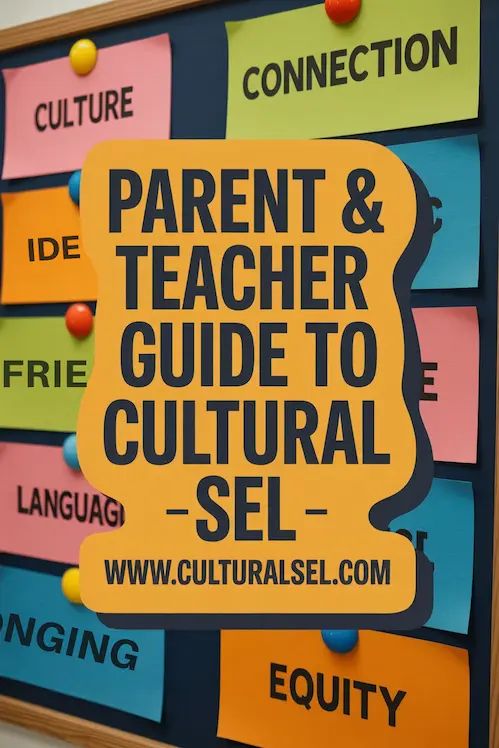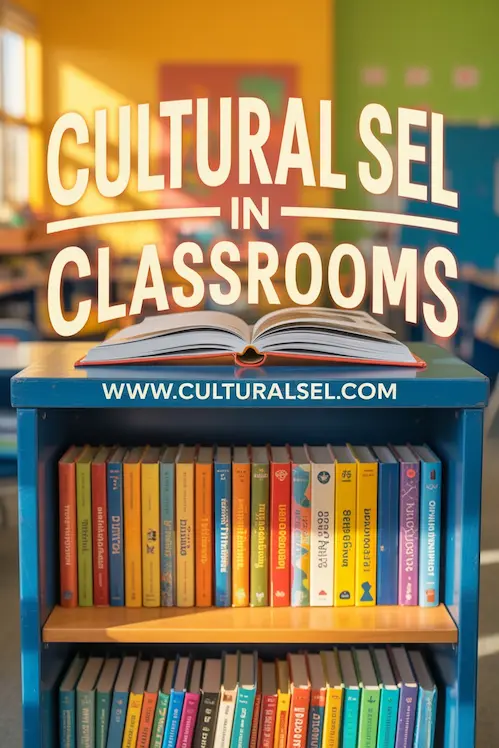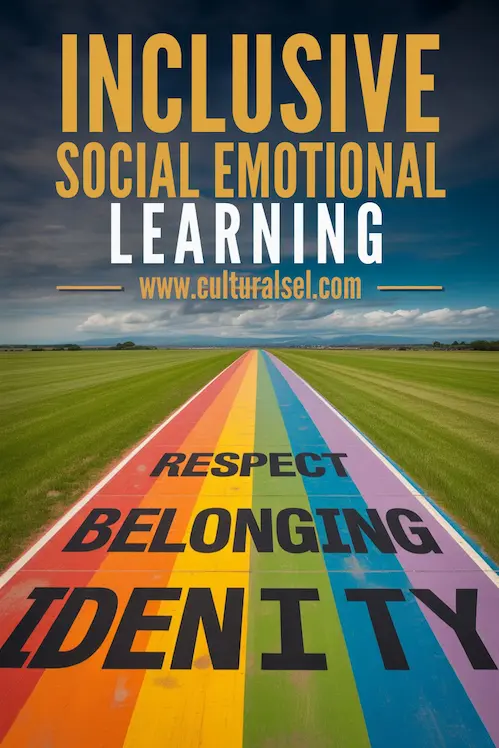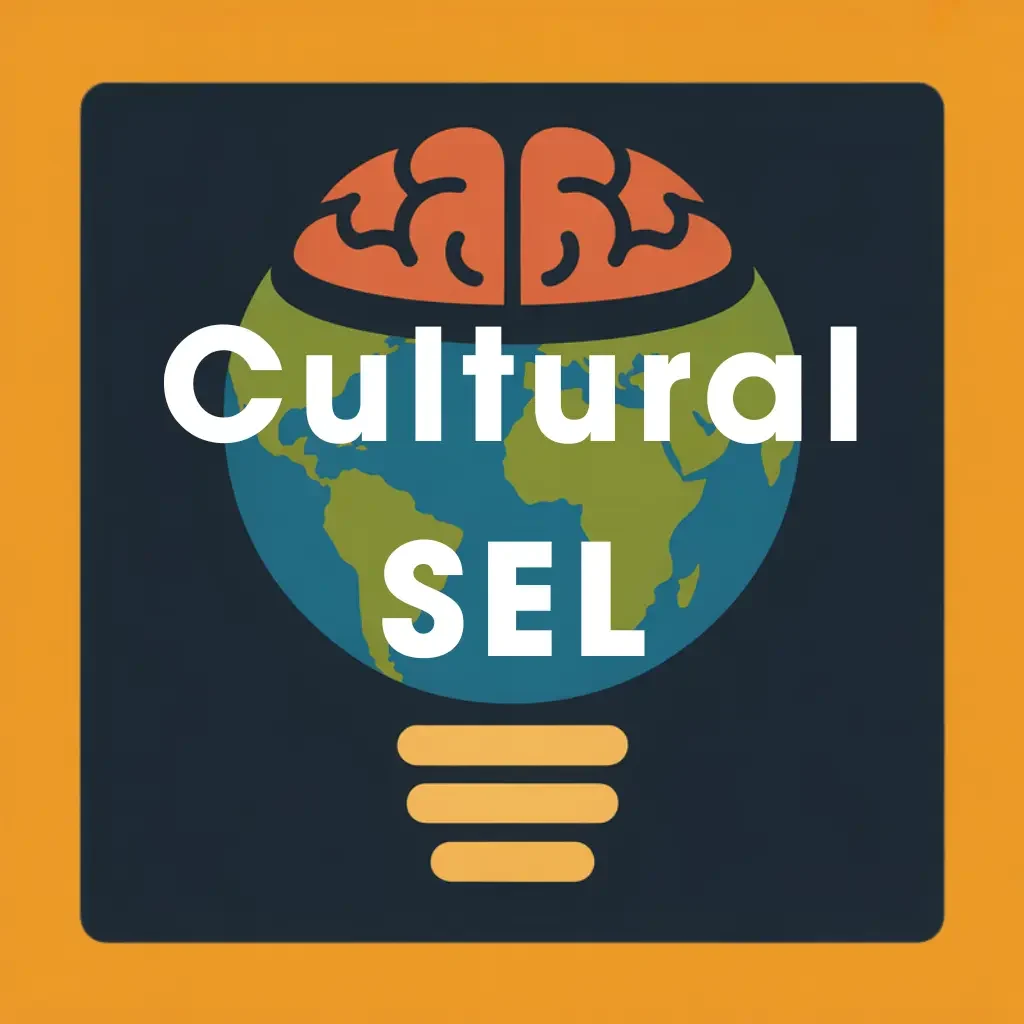Culture in SEL: A Guide to Culturally Responsive SEL for Inclusive Classrooms

THIS POST MAY CONTAIN AFFILIATE LINKS. THIS MEANS WE MAY RECEIVE A COMMISSION FROM QUALIFYING PURCHASES YOU MAKE THROUGH OUR LINKS. KINDLY READ OUR DISCLOSURE NOTICE FOR MORE INFORMATION.
Are students only seen when class activities look like an urban or a trending playlist?
Many teachers and parents want to celebrate culture in SEL, but they feel boxed in by narrow ideas.
Culturally responsive SEL should reflect the full lives of students, not just one style or one scene.
This post shows how to build inclusive social and emotional learning with many cultural doorways.
You will learn what culturally responsive SEL is, why stereotypes miss the mark, and how to bring diverse cultural elements into daily practice.
The goal is simple, culturally responsive SEL that grows confidence, connection, and identity for every learner.
🧠 General SEL + 🌍 Cultural Understanding = 💡 Empowered, Connected Learners
What Is Culturally Responsive SEL Beyond Stereotypes?
Culturally responsive SEL is the practice of teaching social and emotional skills through students’ real cultures, values, and experiences.
It respects home languages, family traditions, and community histories. It uses those assets to build self-awareness, empathy, and strong relationships.
It includes diverse cultural elements in SEL, not only popular urban examples.
Stereotypes limit connection. When culture gets reduced to a single genre or a single activity, many students feel unseen.
A quiet student from a farming community, a newcomer with strong oral storytelling at home, a child who prays daily with family traditions, a teen who cares for siblings after school, each brings cultural wisdom that can power SEL.
Inclusive social emotional learning makes room for all of that.
Research and practice centers back this up. State frameworks on culturally responsive teaching urge schools to embed SEL in classroom routines and to use student data and voices to shape lessons.
CASEL guidance highlights adult cultural competence, identity affirmation, and inclusive curriculum.
University centers point to storytelling, group problem-solving, and discussion about community issues as core moves that help students feel safe, valued, and ready to learn.
Think small and concrete:
- Use stories from many cultures to teach empathy.
- Invite family routines and practices into reflection prompts.
- Connect SEL goals to community strengths, like mutual aid or intergenerational care.
Why Stereotypes Miss the Mark
When culture gets reduced to a single sound or scene, many students are left out. Some learners prefer quiet reflection or faith-based practices.
Others connect through nature, crafts, or family work. I’ve even had people suggest adding hip hop cyphers as the only way to “bring in culture,” but that misses the wider picture.
If we rely on just one example, students can feel like guests in their own classroom.
This approach has real costs:
- Students may feel their identity is ignored.
- Families may not see their values in school.
- Engagement drops, and behaviors rise.
A broader view affirms all identities. Current guidance on culturally responsive SEL shows higher belonging when classrooms respect many ways of speaking, learning, and sharing.
Students build trust when they hear stories, see faces, and use texts that reflect their worlds.
They participate more when activities link to their home lives. They learn to respect peers because the class models that respect first.
Core Elements of Inclusive Cultural SEL
Inclusive cultural SEL rests on three pillars:
- Affirm identity: Name, language, family structure, traditions. Build SEL around who students are, not who we expect them to be.
- Think critically: Let students discuss real social issues that affect their communities, at age-appropriate levels. Voice and choice matter.
- Build community: Use routines that honor many cultures, like check-ins, cooperative tasks, or circle time, and match SEL competencies with cultural practices beyond music.
Examples that connect SEL skills to culture:
- Self-awareness through family origin stories or personal artifacts.
- Social awareness through community helpers, elders, or local leaders.
- Responsible decision-making through case studies from home or neighborhood life.
How to Bring Diverse Cultures into Your SEL Practices
Start with relationships, then design activities that reflect your students. The aim is not to guess culture, it is to invite it.
Simple steps for culturally relevant SEL activities:
- Ask, do not assume: Use quick surveys, interest maps, and family chats. Ask about languages, favorite stories, community events, foods, games, and rituals.
- Build a rotating library: Add picture books, short texts, folktales, and poems from many cultures. Use them in daily SEL prompts.
- Use multiple modes: Talk, draw, act, write, create audio. Let students choose how to share feelings and ideas.
- Tie SEL to real life: Map competencies to daily tasks. For example, self-management during prayer or mindfulness, perspective-taking during elder care, teamwork in community sports or service.
- Invite family voices: Welcome guest readers, recipe shares, or tradition spotlights. Keep it low pressure and opt-in.
- Discuss current issues with care: Facilitate short, guided talks on topics students bring up. Connect them to facts, empathy, conflict resolution, and values.
Tips to avoid stereotypes:
- Let students lead with their stories.
- Never assign a student to speak for a whole group.
- Offer many examples, not a single cultural symbol.
- Review materials for bias and tokenism.
Benefits you can expect:
- Higher engagement, since students see their lives in the work.
- Stronger relationships, since trust grows with respect.
- Better transfer of SEL skills to home and community.
Practical Ways to Incorporate Varied Cultural Stories
Stories are a doorway into heart and mind. Use them to teach empathy, identity, and problem-solving.
Try these ideas:
- Folktales for empathy: Choose tales from Indigenous nations, West African griot traditions, or East and South Asian fables. Pause to ask, what is the character feeling, and why?
- Family rituals for connection: Invite students to share a small ritual, like a morning greeting, snack prayer, or weekend routine. Link it to self-management or gratitude.
- Oral history moments: Record or retell a grandparent story. Practice active listening and note-taking. Reflect on lessons learned.
- Local heroes for agency: Highlight a community organizer, nurse, librarian, or coach. Discuss choices they made and values they showed.
- Language snapshots: Learn and use greetings from students’ home languages during check-ins. Celebrate identity and belonging.
Example prompt: Share a smell, sound, or saying from home that calms you. Connect the share to a calming strategy you can use at school.
Building Confidence Through Cultural Connections
Confidence grows when students see their culture as a strength. Link SEL skills to what students already do well in their lives.
Ideas for teachers:
- Use name stories to build self-awareness and pride.
- Celebrate bilingual problem-solving as cognitive flexibility.
- Frame family help, like caring for siblings, as leadership and empathy.
Ideas for parents and community leaders:
- Share a recipe, tool, or game that teaches patience, turn-taking, or focus.
- Host a short circle at home or at the library. Use feelings cards in multiple languages.
- Pair teens with younger kids for reading or story time. Reflect on teamwork and care.
When culture is a bridge, not a box, students take risks, share ideas, and grow. That is equity in action.
“Culture is not a single sound or symbol. It is the everyday way students live, learn, and connect, and SEL is strongest when it makes space for all of it.”
Culture in SEL is wide and deep. It reaches beyond a single sound or scene to include stories, rituals, languages, and daily life.
When classrooms honor many cultures, students feel seen, trust grows, and learning sticks.
You now have a map to start, with steps that invite student voices and connect SEL to real life.
Ready to build connected learners? Download the free starter guide at culturalsel.com, or subscribe for new lessons and tools.
Want quick answers first? Check the FAQ on starting culturally responsive SEL. Thanks for reading, and share how your students light up when their culture shows up.
Frequently Asked Questions about Culturally Responsive SEL
Q: What is culturally responsive SEL?
A: It is SEL taught through students’ real cultures, values, languages, and experiences. It affirms identity, builds belonging, and links skills to daily life.
Q: How do I start culturally responsive SEL?
A: Begin with listening. Use short surveys, family chats, and student-led choices. Select diverse texts, connect SEL skills to home practices, and reflect often.
Q: How do I avoid stereotypes in SEL?
A: Offer many examples from many cultures, let students lead with their stories, and never assign a student to speak for a group. Review materials for bias.
Q: What are examples of culturally relevant SEL activities?
A: Use folktales from Indigenous or Asian traditions for empathy, share family rituals for relationship-building, and discuss local heroes to practice decision-making.
Q: Why include community issues in SEL?
A: Students learn to name feelings, consider others’ views, and make choices that help their community. This builds agency and respect.
Quick Start Guide: Bringing Diverse Cultures into SEL
- Ask, don’t assume
Use a short survey or quick chat to learn about languages, stories, rituals, and interests. - Select diverse materials
Gather picture books, folktales, short texts, and media from many cultures that match student interests. - Match SEL skills to culture
Link self-awareness, empathy, and decision-making to real practices at home and in the community. - Facilitate inclusive sharing
Invite students to share, but never require it. Offer multiple modes like speaking, drawing, or audio. - Reflect and adjust
Ask what felt meaningful to students. Revise materials to avoid tokenism and add more voices.
IF THIS POST RESONATES WITH YOU, EXPLORE MORE OF CULTURAL SEL ON OUR SITE.
You’ll find free guides, practical tools, and reflections to help families, educators, and communities bring culture, identity, and connection into social-emotional learning.
💬 Want to keep the conversation going? Join our Facebook community and connect with others exploring Cultural SEL.
📌 Save or share this post so other families and educators can bring these ideas into their own homes, classrooms, and communities.
Together, we can keep growing, connecting, and raising empowered learners.





